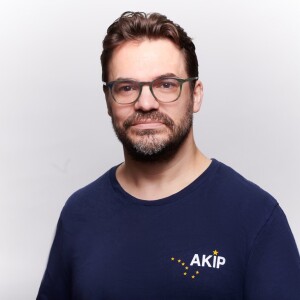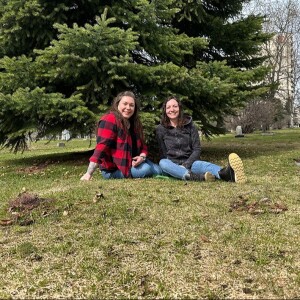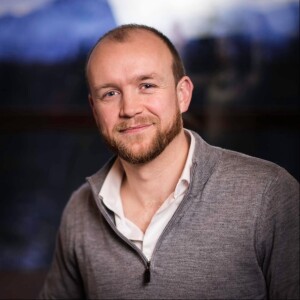Chatter Marks
Chatter Marks is a podcast of the Anchorage Museum, dedicated to exploring Alaska’s identity through the creative and critical thinking of ideas—past, present and future. Featuring interviews with artists, presenters, staff and others associated with the Anchorage Museum and its mission.
Episodes

Friday Aug 09, 2024
EP 92 Reporting on the Alaska fishing industry with Laine Welch
Friday Aug 09, 2024
Friday Aug 09, 2024
Laine Welch has been reporting on the Alaska fishing industry for 36 years, and during those years her goal was always to show where Alaska fits into the global commodities market because seafood is one of the largest commodity items sold throughout the world. Given Alaska’s commercial fishing market, there’s always been a real opportunity to be a major player in the global seafood market. But Laine says we tend to squander our potential profits. For example, there are plenty of revenue streams that could be taken advantage of in areas like cosmetics and pharmaceuticals. Or how almost 75 percent of all of the value from groundfish — Alaska’s number one species in terms of volume — goes out of state. Primarily to Seattle.
She says that when she first started reporting on the Alaska fishing industry she tamped down her criticism of it, and instead chose to be its cheerleader. But when she retired two years ago, she felt a new sense of responsibility and freedom to point out areas of the industry that could use improvement. She was no longer beholden to only reporting on the good or acceptable news. So, in retirement, she’s been focusing on issues like the lawful waste of seafood caused by bycatch — the catching and discarding of unwanted sealife. She says that every other protein industry has a philosophy of using the whole animal, what they call ‘from the rooter to the tooter.’ But in Alaska, they take the filet and the rest goes. This has always been important — avoiding waste and maximizing profit — but it’s especially important now, when the economy of Alaska needs new revenue streams.

Wednesday Jul 24, 2024
EP 91 Pastries, science and baking in extreme environments with Rose McAdoo
Wednesday Jul 24, 2024
Wednesday Jul 24, 2024
Rose McAdoo is a pastry chef and an artist. But it wasn’t until recently that she started embracing the title of artist because she had identified so strongly with being a pastry chef.
She’s been working in kitchens since she was 14, and then when she became a chef she decorated wedding cakes in New York. It was a dream job, until it wasn’t. She realized that she wanted more out of her work, an opportunity to make a difference. So six years ago she took a job in Antarctica as a sous chef — today she splits her time between there and Alaska. Her surroundings and the scientists she worked around in Antarctica eventually inspired her to create something that could help share their science. That’s when she began creating cakes that convey scientific ideas.
She’s traveled to and worked in some of the most extreme and remote environments in the world — Antarctica, a volcano summit in Kenya, underground in the Australian Outback, on a ship in Svalbard. Rose says that nothing is controllable in these places, and that the control lies in the planning she does before she goes into a given environment. She has to be flexible and able to pivot because the weather and the conditions could change at any minute.
Given the seriousness of the environments she works in, she appreciates the levity of cake. How it allows people to let their guard down and be receptive to scientific ideas about issues like climate change. However, she does struggle with the potential impact of what she’s doing — she says she doesn’t want to be seen as a “little cake maker just posting on Instagram.” She wants her work to carry meaning and to create larger conversations.

Wednesday Jul 10, 2024
EP 90 Art, paleontology and dad jokes with Ray Troll
Wednesday Jul 10, 2024
Wednesday Jul 10, 2024
Ray Troll is an artist, and he describes himself as a paleo-nerd. Ever since he was a kid, he’s been obsessed with dinosaurs. In fact, before he even learned how to spell his own name, he learned how to spell “dinosaur.” They were also the first things he remembers drawing. He says that as a child drawing was his superpower — it endeared him to his teachers and classmates. Then, around 5th grade, he got a hold of issues of Mad Magazine and Cracked Magazine. He was immediately drawn to the offbeat, dark humor. So much so that it was forever infused into his artistic style and sensibilities. It’s evident in one-liners like “Spawn Till You Die,” “Return of the Sockeye,” and “Baitful Dead” that accompany illustrations of humans and sea life.
He says he loves surrealism because it’s something you can’t really explain rationally. It’s bizarre, almost dreamlike, and it speaks to you on a gut-level. It might be visually appealing, it might convey a message or it might be a joke. Much of Ray’s art comes from a place of humor, but a lot of truth can be said in jest. Musings on deep-time and nature and culture all wrapped up in a dad joke. For him, art is about learning and cataloging — with planes when he was a kid and later with fish after he moved to Alaska in 1983. He says that drawing is about learning to see. It’s about the accumulation of knowledge and wisdom that you gain throughout your lifetime.

Monday Jun 24, 2024
EP 89 Memories and Monsters Part 2: Sasquatch encounters
Monday Jun 24, 2024
Monday Jun 24, 2024
In this episode, Cody talks to Fred Roehl and David Holthouse about sasquatch encounters. Fred is a YouTuber and a Sasquatch, or Hairy Man, oral historian. His channel is called “The Subarctic Alaska Sasquatch and Alaska’s Little People” and in it he narrates Sasquatch encounters and also interviews people who tell their Sasquatch stories. At this point, he’s collected over 200 of them, and he says that there are a couple common themes throughout: Sasquatch is either pushing humans out of a territory or they’re watching them. To Fred, Sasquatch is an adversarial predator. So, sharing these stories is a form of public safety — similar to being bear aware. It’s a perspective and a healthy fear that he grew up around in Bristol Bay.
David Holthouse is an investigative journalist, and his perspective comes from the intersection of belief and propaganda. How the idea of Sasquatch can be used to enforce territorial claims, or as a warning to keep people in-line, as was the case with his 2021 docu-series, “Sasquatch.” The concept of the show is based on a story he heard in 1993, about a Sasquatch killing three people on a weed farm in Northern California — an area that David says reminds him of Alaska. The story goes beyond Sasquatch, though. At its core it’s about long-standing social issues like racism, the war on drugs, gangs and violence.
In this Chatter Marks series, Cody talks to storytellers and knowledge holders about Sasquatch, in its many variations, and its personal and cultural importance to the people of Alaska.

Monday Jun 10, 2024
EP 88 Memories and Monsters Part 1: Sasquatch in interior and coastal Alaska
Monday Jun 10, 2024
Monday Jun 10, 2024
In this episode, Cody talks to Dehrich Chya and Angela Gonzalez about the cultural importance of Sasquatch. Dehrich works at the Alutiiq Museum in Kodiak and Angela is an Athabascan artist and writer. Dehrich’s perspective is of coastal Alaska. He says that the Alutiiq people call Sasquatch or Bigfoot creatures Aula’aq, and its temperament ranges from being a threat to being a menace to being used as a cautionary tale. For example, parents might use stories of Aula’aq to warn their children away from dangerous areas. And stories of its appearance vary. Some describe it as tall, while others describe it as short, but it’s always hairy and many believe it to be a shapeshifter.
Angela’s perspective is of interior Alaska. Growing up, she says that talking about Bigfoot was taboo, but that there are certain times of the year — mainly winter — when it’s appropriate to talk about it. Bigfoot is a powerful being, so it’s important to give it a lot of respect. While the curious might seek out stories of Bigfoot, others will avoid them out of fear of inviting that presence into their life. Angela says that it comes down to respecting the land, the animals and the water. Because in order to survive, we must live in harmony with our surroundings; we have to respect the symbiosis that exists between humans and nature.
In this Chatter Marks series, Cody talks to storytellers and knowledge holders about Sasquatch, in its many variations, and its personal and cultural importance to the people of Alaska.

Friday May 31, 2024
EP 87 Exonerating Alaskans with Jory Knott
Friday May 31, 2024
Friday May 31, 2024
Jory Knott is the Executive Director of the Alaska Innocence Project. The Alaska Innocence Project started in 2008 under the direction of Bill Oberly, and it took seven years for them to get their first exoneration — it was the Fairbanks Four case, in which four Alaska Native men were wrongly convicted of murder and subsequently spent 18 years in prison. Jory says that that case involved a number of factors that led to a wrongful conviction, including eyewitness misidentification, incentivized witnesses, confirmation bias, racial animus, misconduct, and bad science. This was the case that got Jory interested in working with the Innocence Project — he was an intern then, but made the decision to go to law school so that he could work there full-time.
Studies that consider the number of people who have been wrongfully convicted in the U.S. since the late-1980s estimate that up to 5 percent of the prison population is wrongfully convicted. In Alaska, that would mean about 150 innocent people are in prison. Nationally, the average person who is wrongfully convicted spends 12 years in prison before they’re exonerated. And Alaska is among about a dozen other states that do not have a wrongful conviction compensation statute, so exonerees don’t get any money following their release. Even convicted felons receive things like re-entry services, recidivism prevention, education, job services and drug counseling. But Jory says that, despite all of this, he still has faith in the criminal justice system because, for the most part, it gets it right and wrongful convictions are rare.

Thursday May 09, 2024
EP 86 Things can get better with Heidi Huppert
Thursday May 09, 2024
Thursday May 09, 2024
In this episode, Cody and co-host Aurora Ford talk to Heidi Huppert. Aurora is a former journalist and currently works at Covenant House Alaska; Heidi is the Chief Program Officer at Covenant House. Heidi’s perspective on homelessness in Alaska is unique because, in her younger years, she spent time on the streets of Anchorage. Her mom had a violent and abusive boyfriend and Heidi didn’t feel safe at home. So, one night after an especially brutal domestic situation, she found herself wandering around Spenard, trying to figure out what she was gonna do. She was about 12 years old and she had school in the morning. Because it was open and because it was familiar, she ended up just hanging out at McDonald’s.
She says that, for a long time, she didn’t tell her story. It was just too hard to relive those memories, and the violence and the pain that came with them. But right now, she’s at a point in her life where she sees how much power and strength there is in telling her story. How it can potentially help a young person understand that they might be in the middle of the worst moment or moments of their life, but it won’t last forever. Things can get better.
Heidi says that the issues of homelessness and human trafficking — another issue that she deals with a lot at work — are ones that we have to care about because they involve young people and they are the future of Alaska. They will one day hold the political, economic and social power. So, if we want our state to be healthy, we have to care about what is happening to our young people.

Wednesday Apr 24, 2024
EP 85 Furniture, basketball and family with Buddy Bailey
Wednesday Apr 24, 2024
Wednesday Apr 24, 2024
In the late 1990s, Buddy Bailey became the face of his dad’s furniture business, Bailey’s Furniture. He was 7 years old when he appeared in his first commercial — the crew filming it realized that the furniture itself didn’t have much character, so they suggested that Buddy get in front of the camera. He was a natural — his charisma and affability came easy. He’d chat about furniture and deals, and he’d even spin a basketball on his finger while he did it.
As the years went on, he became a local child celebrity. He continued being in Bailey’s Furniture commercials, and he was becoming a rising basketball star. When he was 15 or 16 years old, he remembers the Anchorage Daily News came out with a list of the most recognizable faces in Alaska and Buddy was number two, right behind U.S. Senator Ted Stevens.
Buddy says the lessons he learned from working at Bailey’s Furniture helped him on the basketball court. In basketball, like in retail, you’re dealing with personalities and egos, but you’re not always worried about money. So, basketball was easy. All he had to do was focus on scoring points and winning. This mentality, as well as his skill on the court, brought him all the way to playing college ball.
Today, he no longer works at Bailey’s Furniture, he quit in 2013 to pursue a career in finance and then in 2020 he founded a virtual lease-to-own business. He no longer plays ball semi-professionally either, but he does play recreationally. He says he’s probably a better shooter than he ever was and a better overall basketball player. He plays one-on-one almost every day at his local gym. He also coaches both of his kids’ basketball teams, teaching them that it’s not always about winning, it’s about learning life lessons and values — accountability, work ethic, the ability to fight for what you believe in, and how all of that will eventually filter over to your family.


